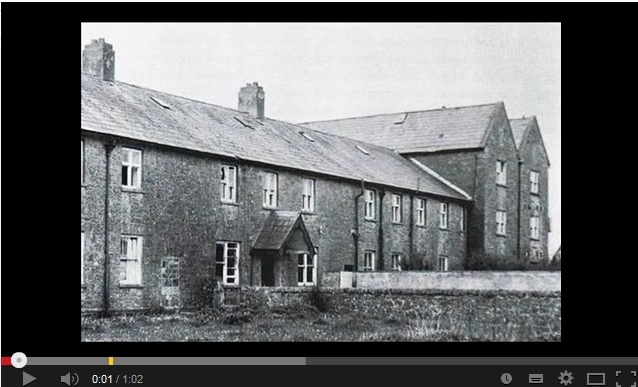아일랜드 수녀원에서 미국으로 입양간 아들을 추적하는 어머니의 이야기를 다룬 영화 "필로미나의 기적"을 이해하는 데 도움이 되는 기사를 발견하다
"
아일랜드 서부의 한 가톨릭 수녀원이 수십년 전에 운영했던 미혼모 보호시설 부근에 근 800구에 달하는 유아와 어린이 시신이 무더기로 암매장돼 있다는 사실이 밝혀져 충격을 주고 있다.
4일 AP통신 보도에 따르면 아일랜드 역사학자 캐서린 콜리스는 카운티 골웨이의 투암 마을에서 지난 1925년부터 1961년까지 운영됐던 '성모의 집'에 수용된 어린이 가운데 모두 796명이 인근 지역에 묘비나 관도 없이 집단적으로 매장됐음을 밝혔냈다.
 |
| (YouTube capture) |
콜리스는 문제의 시설을 담당한 '봉 세쿠르'(Bon Secours) 수녀원 측이 작성한 사망 기록을 살펴본 결과, 연령별로는 갓난 아이에서 최고 8살 어린이까지 포함돼 있었으며 주로 영양실조와 홍역, 결핵과 같은 전염병에 걸려 숨진 것으로 나타났다 고 말했다.
그녀는 오랫동안 방치돼 있다가 1975년 콘크리트 덮개가 무너지면서 우연히 발 견된 '성모의 집' 뒤편의 정화조가 집단 매장지였을 것으로 보인다면서 당시 이를 본 마을 소년들은 수많은 해골, 인골들이 가득해 넘칠 지경이었다는 목격담을 전했 다고 말했다.
'성모의 집'은 문을 닫은 이후 50여년 동안 방치돼 있었으나 현재는 재개발로 주택과 어린이 놀이터가 조성돼 있다. 정화조 주변은 아직 개발이 되지 않은 상태다 .
투암 마을 주민들은 지금까지 이들 인골이 지난 1840년대 당시 수십만의 아사자 가 속출한 아일랜드 대기근 당시 숨진 이들의 것으로 믿고 있었다.
'성모의 집'은 20세기초 아일랜드에서 운영된 몇몇 미혼모 보호시설 가운데 하나로, 당시 미혼모들은 보수적인 가톨릭 국가였던 이 나라에서 '타락한 여자들'로 낙인찍혔고 출산한 아이들은 입양을 강요받았다.
미혼모 보호시설들의 여건은 열악한 상태였다. 1944년 '성모의 집'을 시찰한 정 부의 관리들의 보고서는 이곳에 수용된 어린이 가운데 일부는 "허약하고 배가 불룩 했으며 수척했다"고 적고 있었다.
미혼모가 낳은 아이들은 세례는 물론 교회 묘지 매장을 거부당했다. 워싱턴 포스트는 미혼모들이 일자리를 찾아 '성모의 집'을 떠난 이후 남겨진 아이들은 학교에 서도 무시와 차별을 당했다고 전했다.
당시를 기억하는 마을 주민들은 미혼모 자녀들이 교실 구석에 따로 떨어져 앉아 있었다고 회고했다. 한 주민은 현지 일간지 아이리시 센트럴에 "보통 취학 연령 무렵에는 입양되거나 죽곤 했다"고 말했다.
워싱턴 포스트에 따르면 콜리스는 "기록을 보면 한 주에 2명이 사망하고 있었다 "면서 "어떻게 이런 일이 벌어질 수 있었는지 아직도 알아보고 있는 중"이라고 말했다. 마을 주민들은 암매장된 어린이가 800명이 넘을 수도 있다고 보고 있다.
이번 발표는 아일랜드 가톨릭 교회가 운영하는 여러 교육기관들에서 과거 수십 년간 어린이들을 학대했다는 충격적인 사실이 밝혀진데 뒤이은 것이어서 현지 가톨릭 교회의 어두운 과거가 다시 한번 조명을 받을 전망이다.
찰리 플래너건 아일랜드 청소년부 장관은 "심히 우려스럽고 충격적"이라고 말하 고 이 문제를 다룰 최선책을 적극 검토할 것이라고 말했다.
투암 교구의 마이클 니어리 대주교는 집단 매장된 모든 미혼모 자녀들의 이름과 나이를 새긴 추모비를 건립하자는 움직임이 있는 것과 관련, '봉 세쿠르' 수녀원 간부들과 만나 이를 돕는 문제를 논의할 것이라고 말했다. (연합)
<관련 영문 뉴스>
Irish church under fire over children's mass grave
The Catholic Church in Ireland is facing fresh accusations of child neglect after a researcher found records for 796 young children believed to be buried in a mass grave beside a former orphanage for the children of unwed mothers.
The researcher, Catherine Corless, says her discovery of child death records at the Catholic nun-run home in Tuam, County Galway, suggests that a former septic tank filled with bones is the final resting place for most, if not all, of the children.
Church leaders in Galway, western Ireland, said they had no idea so many children who died at the orphanage had been buried there, and said they would support local efforts to mark the spot with a plaque listing all 796 children.
County Galway death records showed that the children, mostly babies and toddlers, died often of sickness or disease in the orphanage during the 35 years it operated from 1926 to 1961. The building, which had previously been a workhouse for homeless adults, was torn down decades ago to make way for new houses.
A 1944 government inspection recorded evidence of malnutrition among some of the 271 children then living in the Tuam orphanage alongside 61 unwed mothers. The death records cite sicknesses, diseases, deformities and premature births as causes. This would reflect an Ireland that, in the first half of the 20th century, had one of the worst infant mortality rates in Europe, with tuberculosis rife.
Elderly locals recalled that the children attended a local school _ but were segregated from other pupils _ until they were adopted or placed, around age 7 or 8, into church-run industrial schools that featured unpaid labor and abuse. In keeping with Catholic teaching, such out-of-wedlock children were denied baptism and, if they died at such facilities, Christian burial.
It is well documented that throughout Ireland in the first half of the 20th century, church-run orphanages and workhouses often buried their dead in unmarked graves and unconsecrated ground, reflecting how unmarried mothers - derided as "fallen women'' in the culture of the day - typically were ostracized by society, even their own families.
Records indicate that the former Tuam workhouse's septic tank was converted specifically to serve as the body disposal site for the orphanage.
Tuam locals discovered the bone repository in 1975 as cement covering the buried tank was broken away. Before Corless' research this year, they believed the remains were mostly victims of the mid-19th century famine that decimated the population of western Ireland.
Respectful of the unmarked grave in their midst, residents long have kept the grass trimmed and built a small grotto with a statue of the Virgin Mary. (AP)
'영화감상기' 카테고리의 다른 글
| 카사블랑카(Casablanca) (0) | 2016.08.27 |
|---|---|
| 인상깊은 영화 대사 (0) | 2014.07.28 |
| Holy Motors의 우린 누구였나 ? (0) | 2014.05.21 |
| 필로미나의 기적과 기네스 맥주 그리고 아일랜드 하프 (0) | 2014.05.18 |
| 해피엔딩 프로젝트(원제:Still mine) (0) | 2014.02.19 |